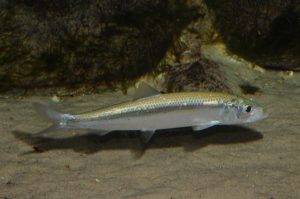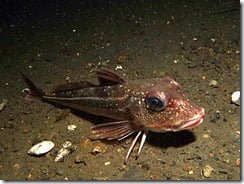 The Atlantic mackerel is a common and widespread fish around Irish coasts. A favourite with anglers, it is often caught in great numbers during the summer when huge shoals move inshore to feed on vast numbers of herring fry and sand eel.
The Atlantic mackerel is a common and widespread fish around Irish coasts. A favourite with anglers, it is often caught in great numbers during the summer when huge shoals move inshore to feed on vast numbers of herring fry and sand eel.
Mackerel is a handsome, streamlined fish that belongs to the same family as tuna. Like its larger relative the mackerel is designed for speed and agility. It is a commercially important species that is fished extensively throughout its range. It is silver underneath and the upper surface is an iridescent blue-green punctuated with attractive dark bands. The head is long, with large eyes and a large mouth that’s armed with small sharp teeth. There are two dorsal fins on the back, the first originating over the middle of the pectoral fins and the second nearer the tail.
The species is a resident of the north Atlantic ocean and the Baltic, Mediterranean and Black seas. There are two main stocks in the north-east Atlantic, the North Sea stock to the east and the British Isles stock – which includes the mackerel in Irish waters – to the west.
Adult fish are usually between 35 to 46 cm (c. 14 to 18 inches) long, with some reaching lengths of up to 56 cm (c. 22 inches). They typically weigh between and 0.45 and 1.8 Kg (1 lb and 4lb). Occasionally very large mackerel are landed, like the 3.4 Kg (7.5 lb) specimen caught from the schooner Henrietta off the east coast of the USA in 1925.
Mackerel are pelagic, which means that they are free swimming and live their lives in the open ocean. The species is found between the surface and a maximum depth of around 1,000 metres (c. 3,281 feet). Adult mackerel spend winter in deeper water offshore, but as the water warms in spring and summer they move inshore and form huge schools containing many thousands of fish near the surface.
Because they breathe using a method known as ram ventilation mackerel have to swim constantly to ensure a continuous flow of water over their gills. Mackerel are generally most active during the day, when they feed on a small fishes like sand-eel and herring fry, as well as zooplankton (tiny crustaceans and other animals) that they filter from the water. Seeing a huge shoal of mackerel feeding at the surface on an even larger shoal of herring fry is quite a spectacle, and is not uncommon around the Irish coast during the summer months.
Spawning takes place in the open ocean, and eggs and sperm are released into the water. Each egg contains a small globule of oil that gives it buoyancy and keeps it near the surface. Once hatched the tiny mackerel feed on the larvae of minute crustaceans called copepods. As they grow they start taking adult copepods and other zooplankton. Most of the eggs, larvae and young fish will fall prey to larger predators during their time in the plankton. Those that survive grow quickly, and will reach a length of about 25cm (c. 10 inches) in their first year. Mackerel can live for up to 25 years, although in reality few will reach that age.
Like many commercial marine fish species mackerel populations are under intense fishing pressure throughout their range. During the 1960s mackerel stocks in the north-east Atlantic plummeted as a direct result of overfishing. Although mackerel populations can recover moderately quickly given the opportunity, sustained overfishing represents a very real threat to the long term prospects of this common fish species.










1 comment
Brendan Quinn
Hello Calvin, I met you briefly near Galley head recently, before heading out on Holly Jo, I’m a director of IWDG.. I came across several large shoals of small fish leaping clear of the water at speed (either to avoid my sea kayak, or cormorants, no other predators were visible), sea state 1…which looked like very young mackerel (about 20cm), but this is very small for this time of year, and is that their normal behaviour? it was off Inishmurray in Sligo, interestingly there was also a group of leach’s petrels! Some pelagic science guys reckon Garfish, I’m not convinced, maybe herring? They had greenish back, silvery, long, and a distinct deep v-shaped tail. all offshore, started seeing them 2 miles out,